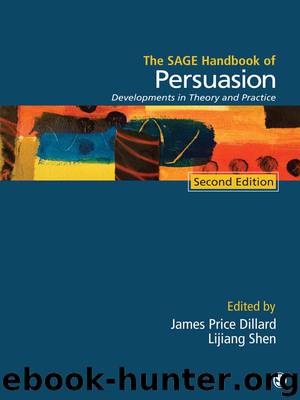The SAGE Handbook of Persuasion by James Price Dillard & Lijiang Shen

Author:James Price Dillard & Lijiang Shen
Language: eng
Format: mobi
ISBN: 9781412983136
Publisher: SAGE Publications
Published: 2012-09-18T14:00:00+00:00
CHAPTER 14
Inoculation Theory
Josh Compton
After Michael Pfau and I offered what was, prior to this chapter, the most comprehensive narrative review of inoculation scholarship (Compton & Pfau, 2005), we concluded that inoculation, while a mature theory, was “far from retiring” (p. 136). We predicted prodigious theory development and application, and as this review will show, this happened and is happening. Researchers continue to propel inoculation scholarship forward in quantity and theoretical depth. Some scholarship confirms findings from the first years of the theory; other discoveries challenge fundamental assumptions about resistance in general and inoculation theory in particular. And all the while, the original analogy is pulled and stretched.
Inoculation theory maintains a complicated relationship with its analogical namesake. More than rhetorical flourish, the analogy was intended to serve, in the words of its creator, as inoculation’s “theoretical point of departure” (McGuire, 1964, p. 222). There is a logic in analogy—an analogic (Holyoak & Thagard, 1995, p. 2) unique to theorizing with analogy—that, in inoculation theory, weaves biological resistance processes with persuasion resistance processes. While some resistance dynamics line up neatly, others have looser connections, and still others seem, at least at first glance, to be independent of the analogy. Although one-to-one connections between characteristics of sources and targets are not requirements for analogical transfer, when they are present, they are useful (Holyoak & Thagard, 1995). After identifying purported gaps between the two resistances, some have called for reconsideration of the analogy (e.g., Wood, 2007).
Because of the historical and contemporary importance of the analogy in inoculation theory’s story, the analogy will never be far from our considerations in this chapter. Initially, the chapter focuses on how the early model of inoculation held tightly to the analogy to explain how inoculation confers resistance. After considering how, the chapter turns to where by tracing inoculation theory’s applications in health, politics, and commerce. Next, the basic model and its analogical premises are confronted in a survey of some of the most important contemporary issues facing the theory as the chapter outlines analogical connections with mediators, moderators, and outcomes. The chapter concludes with a suggested agenda for the next generations of inoculation scholarship—an agenda that recognizes and challenges inherent assumptions of the analogy.
Download
This site does not store any files on its server. We only index and link to content provided by other sites. Please contact the content providers to delete copyright contents if any and email us, we'll remove relevant links or contents immediately.
Rewire Your Anxious Brain by Catherine M. Pittman(18554)
Talking to Strangers by Malcolm Gladwell(13223)
The Art of Thinking Clearly by Rolf Dobelli(10225)
Mindhunter: Inside the FBI's Elite Serial Crime Unit by John E. Douglas & Mark Olshaker(9204)
Becoming Supernatural by Dr. Joe Dispenza(8120)
Change Your Questions, Change Your Life by Marilee Adams(7635)
Nudge - Improving Decisions about Health, Wealth, and Happiness by Thaler Sunstein(7616)
The Road Less Traveled by M. Scott Peck(7523)
The Lost Art of Listening by Michael P. Nichols(7409)
Enlightenment Now: The Case for Reason, Science, Humanism, and Progress by Steven Pinker(7237)
Mastermind: How to Think Like Sherlock Holmes by Maria Konnikova(7227)
Win Bigly by Scott Adams(7095)
The Way of Zen by Alan W. Watts(6507)
Daring Greatly by Brene Brown(6448)
Big Magic: Creative Living Beyond Fear by Elizabeth Gilbert(5614)
Grit by Angela Duckworth(5523)
Ego Is the Enemy by Ryan Holiday(5294)
Men In Love by Nancy Friday(5157)
Altered Sensations by David Pantalony(5045)
